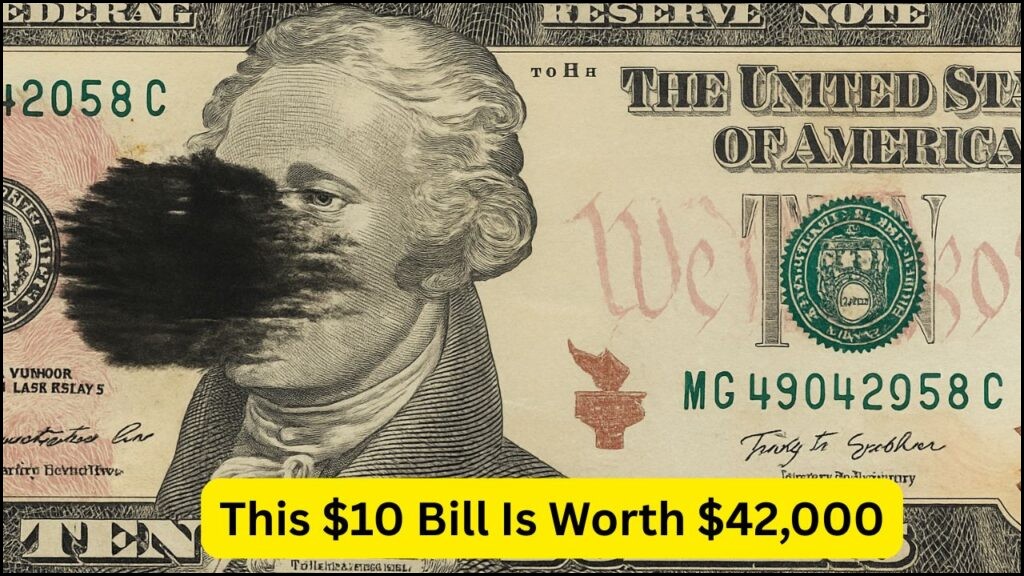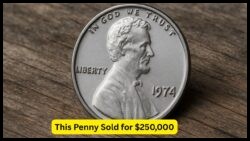$10 Bill – In the fascinating world of currency collecting, even the smallest error can turn an ordinary banknote into a treasure trove. Such is the case with a rare $10 bill that featured nothing more than an ink smear — yet ended up selling for a jaw-dropping $42,000 at auction. It might sound unbelievable, but these types of printing anomalies are highly coveted by collectors due to their rarity and unpredictability. If you’re someone who keeps loose change or old bills in your drawers, this might just be your ticket to a small fortune. Ink smears are considered one of the most eye-catching and accidental printing errors. When the machinery malfunctions or ink gets dragged across the surface of the note, it can create visual distortions that are not only unique but also extremely valuable. Unlike reprints or intentional designs, these flaws are never duplicated, making each error note a one-of-a-kind collectible. Let’s dive into why a smeared $10 bill reached such a high value, what you need to look for in your own cash, and how to determine whether you’re holding onto something incredibly rare.
What Is an Ink Smear Error on Currency?
Ink smear errors occur during the production of paper money, usually at the final printing stages.
- These smears result from excessive or misapplied ink.
- The ink can get dragged or smeared across the paper surface.
- It may affect part of the design, such as the portrait or serial numbers.
- Ink smears are accidental and not part of the original note layout.
- They are considered “obstructive” errors by collectors.
- Each ink smear is unique — no two are identical.
- The severity and visibility of the smear can greatly affect its value.
Collectors place high value on such notes because they represent a rare mistake in an otherwise rigidly controlled production system.
How Did This Particular $10 Bill Sell for $42,000?
This specific $10 note, dated from the 1990s series, shocked the collector community when it hit auction.
| Feature | Description |
|---|---|
| Note Denomination | $10 |
| Error Type | Major Ink Smear |
| Smear Location | Covered most of Alexander Hamilton’s face |
| Serial Number | Clear and intact |
| Condition | Uncirculated / Crisp |
| Auction Platform | Heritage Auctions |
| Final Sale Price | $42,000 USD |
| Buyer Profile | Private Collector |
The large smear distorted Hamilton’s portrait almost completely, making it visually striking. Additionally, the note was in pristine, uncirculated condition, which increased its desirability.
What Makes Ink Smear Notes Valuable?
Several key factors contribute to the value of a currency note with an ink smear:
1. Visual Appeal
- The more dramatic the smear, the higher the potential value.
- Fully smeared portraits are especially rare and eye-catching.
2. Condition
- Crisp, uncirculated notes fetch higher prices.
- Notes with folds, tears, or stains are less desirable.
3. Rarity
- Notes with massive ink coverage are extremely rare.
- If the error was caught early during circulation, few copies may exist.
4. Series and Date
- Older series like those from the 1990s or early 2000s may gain more attention.
- Newer error notes are still valuable but may take time to appreciate.
5. Market Timing
- The demand among collectors can fluctuate.
- Auctions can drive up prices if there’s competition for the note.
How to Check Your $10 Bills for Ink Smear Errors
Don’t underestimate the value of the bills sitting in your wallet or piggy bank.
| Step | What to Do |
|---|---|
| 1 | Examine your $10 bills under good lighting. |
| 2 | Look for any smears, streaks, or blotches. |
| 3 | Focus especially on the portrait area. |
| 4 | Check if the serial numbers are affected. |
| 5 | Avoid damaging the note during inspection. |
| 6 | Use a magnifying glass for small smears. |
| 7 | Take clear pictures if you spot something odd. |
Once you spot a possible error, preserve the bill safely — do not fold or handle it excessively.
Where to Sell or Get It Appraised
Found a potential gem? Here’s what to do next.
Trusted Places for Appraisal and Sale
- Heritage Auctions – Known for high-profile note sales.
- Stack’s Bowers Galleries – Reputable for rare currency.
- PCGS Currency – Offers authentication and grading services.
- eBay (with caution) – Can work if you research the market.
- Local Coin/Currency Dealers – Great for initial consultations.
Before selling, consider getting the note graded officially through PCGS or PMG to maximize value.
Real-Life Cases of High-Value Ink Smear Bills
A few other bills have also sold for impressive amounts due to ink smears:
| Year of Note | Denomination | Description of Smear | Sale Price |
|---|---|---|---|
| 1995 | $20 | Full face smear | $27,000 |
| 2001 | $1 | Green ink streak across back | $3,200 |
| 2013 | $5 | Serial number drag | $5,600 |
| 1999 | $10 | Portrait smear + reverse streaks | $42,000 |
| 2017 | $1 | Ink pool over seal | $1,100 |
| 2006 | $50 | Complete ink pool | $12,500 |
| 2004 | $2 | Blurred border design | $4,200 |
Each of these notes became valuable purely due to ink errors. These mistakes were often missed by the Federal Reserve quality control system, adding to their rarity.
It might seem like a long shot, but it only takes one glance at a forgotten $10 bill to change your financial future. The $42,000 ink smear note wasn’t discovered in a collector’s vault — it was spotted in circulation and authenticated later. Always pay attention to the fine details of your paper money. If something looks off, it might just be your golden ticket.
FAQs
Q1. What exactly is an ink smear on a dollar bill?
An ink smear is a printing error where the ink is accidentally dragged, smeared, or pooled on the bill, often distorting the original design.
Q2. How can I tell if my $10 bill has a valuable ink smear?
Look for major smears on key design elements, like the portrait or seal, and ensure the note is in good condition.
Q3. Are newer bills with ink smears also valuable?
Yes, but older smeared notes tend to sell for higher prices due to their rarity.
Q4. Can I sell a smeared bill online?
Yes, through platforms like eBay or auction houses — but authentication and grading are recommended first.
Q5. What should I do if I find an ink error on my bill?
Avoid folding or damaging it, store it in a protective sleeve, and get it appraised by a currency expert.






